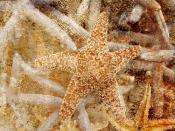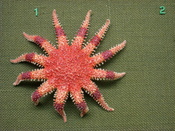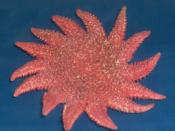Crossaster papposuses are commonly called Rose Sea Stars. Rose Sea Stars are classified as the following:
Kingdom: Animalia
Phylum: Echinodermata
Class: Stelleroidea
Order: Spinulosida
Family: Solasteridae
Genus: Crossaster
Species: Crossaster papposus
Rose Sea Stars lived in the Quarternary Period of the Cenozoic Era of the Geologic time scale. It has lived from 1 million years ago to present day. Other species of that time are man and saber-toothed cats.
Crossaster papposuses usually have anywhere from eight to thirteen arms. The arms can reach from twenty to thirty-five centimeters. At the end of each arm they have things called eyespots. These eyespots are sensitive to light. So they kind of have an idea of where they are going. Some starfish move toward the light, but others like the dark. Their overall diameter ranges in size from eight to fourteen inches. Their mouth area is bare and has two rows of sucker-tipped sensory teeth.
The gave scarlet tops with concentric bands of pink, white, yellow, or dark red with a white underside. It's entire upper surface is cover with brushlike bristles. Starfish have a very large and wide flattened disk. This is where there arms attach. If a starfish's arm is injured or detached it is able to grow a new one. Some species can even become new starfish from detached arms. This is called "Regeneration". Starfish lack both fins and vertabrae, therefore are not true fish.
Rose Sea Stars are know to be dominant predator in their area. They feed on bivalves, cnidarians, and tunicates.
Rose Sea Stars live on the bottom of rocks anywhere from low tide to 1080 feet deep. Crossasters are originally a Japanese species, but are very rare on southern coasts. Starfish are highly mobile. Large individuals can go up to five meters in twelve...



Decent
This is very to-the-point, brief and informative. If this was a subject that I was studying, your work would be helpful.
1 out of 1 people found this comment useful.